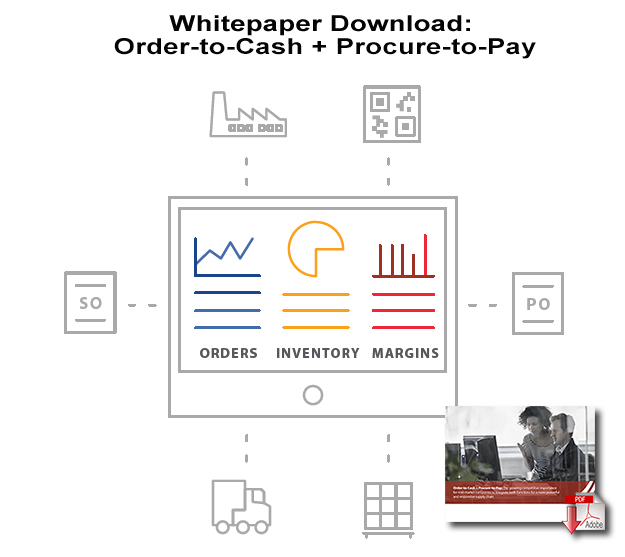Getting to a Holistic End-to-end Supply Chain: 4 Reasons to Integrate Order-to-Cash & Procure-to-Pay

Supplier performance is challenged more than ever in today’s competitive marketplace, where mid-market companies need visibility into their supply chain at the right place and time; the ability to understand and react to global events; and owning the right mix of technology.
Mid-market companies can no longer afford to manage their supply chains in individual silos that often produce inaccuracies in overall performance and constrain supplier relationships.
To combat inefficient operational models, mid-market companies need an end-to-end view of the supply chain by integrating revenue and expense operations.
The ease of implementing and onboarding supply chain management solutions gives wider visibility in manufacturing, as well as orders and inventory.
Bundling order-to-cash and procure-to-pay functions not only gives companies a holistic view of their supply chain operations, but also improves decision-making and business growth.
1. Lack of visibility negatively impacts sales, revenue and customer satisfaction
For sales and operations staff alike, the inability to access current orders, inventory and production information is often a significant source of frustration and waste. When stakeholders lack the level of supply chain visibility that they need, the backlash can affect sales, manufacturing, production, and customer satisfaction. In some instances, sales can become risky; procurement staff maintain higher buffer stock levels as a safety net.
Suppliers are pressed to make cost/quality/time decisions on fulfilling orders. Manufacturing schedules produce more overtime than necessary or result in missed deliverables due to delayed information. A higher number of customer orders end up delayed, incorrect, or have quality issues, resulting in increased returns and lower customer satisfaction rates. All the while, finance watches as the gap between revenue and expense narrows. Creating a more holistic supply chain system—one that ties at all the company’s revenue activities and expense activities and invites trading partners to be stakeholders—helps the company compete more strongly in the marketplace and preserve its financial health.
Mid-market companies should approach this from the perspective of integrating their procure-to-pay system with their suppliers’ order-to-cash systems, and, if possible, with their customers procure-to-pay systems to create an end-to-end chain. This not only provides a number of operational efficiencies, but also helps to close the loop and provide greater communication and accountability for all parties. Every company is different, but here are a few core evaluations to make in the areas of data sharing, tools and reporting.
- For data and information sharing, determine how much manual data entry and manual data sharing is required by your suppliers and customers to do business with you. It may be time to look at some B2B messaging and workflow technology that helps more of your suppliers and customers directly connect and share information, either through data integration or a web portal system.
- Technology tools are another way to build out and reap the benefits of an end-to-end supply chain. Start by identifying existing timesavers that can be implemented for corresponding tasks. For example: how much would more timely document submissions and responses (PO/POACK, ASN, Invoice, etc.) improve productivity and efficiency? The more tasks can be simplified and/or reduced, the lower the operating costs are across your entire supply chain, and that helps everyone be more competitive.
- There’s a lot of buzz around business intelligence (BI) and with good reason. Relevant, accurate and timely reporting of results helps companies to become more proactive and responsive to market conditions. There are a growing number of very affordable BIreporting solutions available, many of them SaaS, so addressing this area with a new solution is much easier than it used to be.
2. Internal silos negatively impact supplier relationships
When a company has a siloed focus, the relationship with trading partners is typically defined within the constraints of the silo. It becomes more difficult to build a partnership with suppliers because the relationship is based on a narrowed scope of performance metrics. For example, if the company’s dealings with a supplier are limited to procurement, those KPIs will be the primary focus on measuring the supplier’s performance. As a result, some important metrics may become over- or under-represented, and valuable input and requirements could end up on the sidelines.
Opening up the relationship and sharing information and metrics across all critical departments gives trading partners insight, allowing them to understand where they can best improve the quality of their products and services to the company. And in most cases, that is exactly what they want to do. Ultimately, it can help companies migrate to stronger and more partner-oriented relationships, which can help carry companies through tough times and go the extra mile.
3. Implementation time and cost are no longer big gating factors
Not only are supply chain management solutions more powerful than ever before, they are also now easier to acquire and implement. Companies today have a variety of viable options to choose from. The growing number of standardized cloud-based supply chain management solutions is driving down cost and implementation time. It’s important to note that this doesn’t result in a less tailored solution.
This new era of solutions has replaced customization with configuration. Expensive modifications have largely been replaced by control panel configuration settings. This makes these solutions not only faster and less expensive to implement, but far less costly to manage and maintain over time;ears become months, and months become weeks. To accelerate things further, some solution providers are also now supporting their customers with implementation and onboarding services so internal resources can continue their work while the new solution is brought on line. Training and ongoing support for staff and vendors is also becoming more commonplace.
4. Chances are your competition is already doing this (or it’s in the works)
Leveraging the supply chain as a competitive advantage is a more prevalent strategy with many companies nowadays as they devise ways to drive more value from business partnerships and processes. Expanded visibility into areas that impact demand and supply can drive up revenue through more confident sales commitments and production planning.
Transforming the supply chain is not something that can (or should) be achieved in haste, but with a committed approach, the transformation can happen more quickly than ever and deliver long-term results.
Mid-market companies will have the visibility and control to better manage both sides of the supply chain while at the same time improving communication and commitment to partners. It’s a win-win.
Brad Huff, Executive Vice President and General Manager for TAKE Supply Chain, Austin, TX, leads the strategy and overall growth of customer, partner and industry relationships through continuous product innovation and value delivery.
He leverages more than 20 years of experience in enterprise supply chain solutions to oversee North American operations.
Article Topics
TAKE Supply Chain News & Resources
5 Ways Businesses Benefit from the Right Supply Chain Orchestration Platform Break Down Costly Supply Chain Data Silos Once and For All Workflow Engine is Your Key to Complete Supply Chain Orchestration How Supply Chain Orchestration Boosts Agility, Simplicity and Business Performance Game Over as Bankrupt Toys ‘R’ Us Files for Liquidation and Begins US & UK Store Closures What Is Supply Chain Orchestration (Really) – And Is It Even Possible? Supply Chain Collaboration Shouldn’t Be Complicated More TAKE Supply ChainLatest in Supply Chain
TIm Cook Says Apple Plans to Increase Investments in Vietnam Amazon Logistics’ Growth Shakes Up Shipping Industry in 2023 Spotlight Startup: Cart.com is Reimagining Logistics Walmart and Swisslog Expand Partnership with New Texas Facility Nissan Channels Tesla With Its Latest Manufacturing Process Taking Stock of Today’s Robotics Market and What the Future Holds U.S. Manufacturing Gains Momentum After Another Strong Month More Supply Chain















